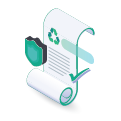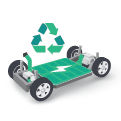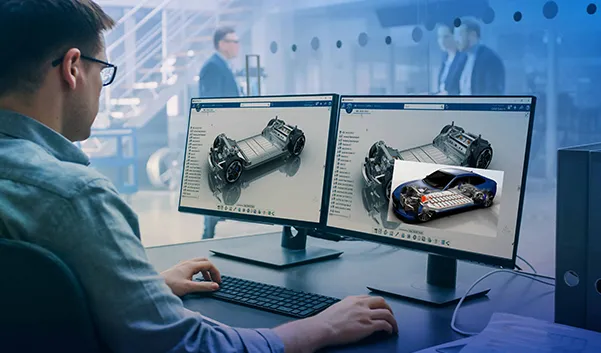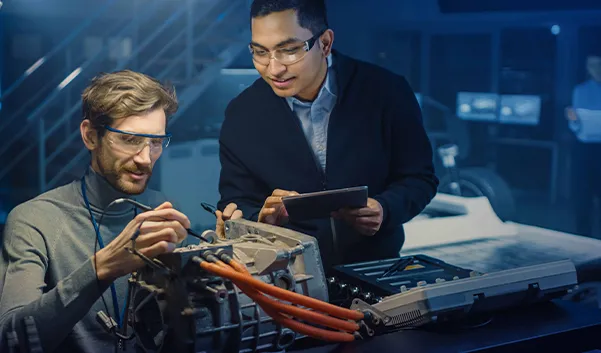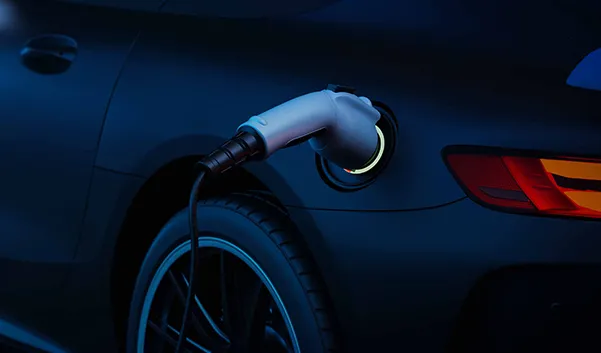Powering Smarter Battery Recycling With Digitalization
Sustain the electric vehicle boom by scaling up cost-effective and durable battery recycling with virtual twin technology on a unified platform.
Scaling Up Sustainable Battery Recycling for the Electric Vehicle Boom
By 2030, at least 1.2 million tons(1) of lithium-ion batteries will reach end-of-life. Are your battery recycling capabilities primed to extract the most out of these spent packs?
The International Energy Agency predicts that more than 145 million(2) electric vehicles (EVs) will hit the roads by 2030. Not only that, OEMs are pressured to deliver EVs with a lower carbon footprint by 2050. However, as the challenge of sustainable EVs grows, so does the pile of spent lithium batteries that once powered those cars. Faced with the shortage and price increase of the components, OEMs and battery manufacturers are boosting their recycling process to recover materials from the returned packs to build new batteries.
Improve the Way You Recover and Recycle
Ready to tame the complexity of battery recycling? Discover how virtual twin technology on a unified platform can help you extract valuable materials safely while lowering the carbon footprint.
Challenges of the Rapidly Expanding Global Battery Market
The global battery market is rapidly expanding. Indeed, the lithium-ion battery demand is expected to grow by about 27% annually between 2022 and 2030(3). But challenges remain:
Regulatory pressure
Authorities are implementing the Digital Product Passport for Batteries, which calls for batteries traceability into the entire lifecycle while mandating higher collection and material recovery rates and recycled components in new batteries.
Finite materials
Mining precious materials like lithium, nickel and cobalt is energy-intensive and takes up a lot of resources and time while often contributing to severe climate impact in South America and Africa's national reserve areas.
Battery recyclability
Most batteries are not designed for recyclability, so recyclers must navigate complex designs, technologies and chemistries that make disassembly costly, time-consuming and energy-intensive.
Digitalize Towards a Low-Carbon Future
When equipped with the right digital capabilities, companies can safely recycle batteries while conserving valuable materials and avoiding waste — from the transportation of spent batteries and disassembly of harmful components to the production of new packs.
The bottom line? Virtual twin technology can help optimize how batteries are reused, remanufactured and recycled while minimizing the environmental footprint. In a digitalized battery value chain, companies can:
- Optimize end-of-life
- Redefine processes
- Strengthen circularity
Optimize end-of-life
A spent EV pack holds about 70 to 80% charge and can be reused to power streetlights or even energy storage systems (ESS). This type of reuse can extend battery life for up to 10 years. But to determine its viability for a second life, companies need to accurately assess the battery’s state of health. By leveraging the virtual twin on a unified platform, companies can gain full traceability to monitor their battery usage and predict which pack will reach end-of-life first.
Redefine processes
It costs more to recycle batteries than to mine more lithium to make new ones. Since large-scale, cheap ways to recycle batteries are lagging, only about 5% are recycled globally, meaning the majority end up as waste. With virtual twin technology, companies can simulate the disassembly and recycling processes based on battery types, technologies, designs and chemistries — and recover materials with the highest quality and the least resources.
Strengthen circularity
A circular economy for lithium batteries ensures responsible hazardous waste disposal through better collection methods and reduces dependency on traditional raw material supply chains. By optimizing the lifecycle through the virtual twin on a unified platform, OEMs and battery manufacturers can close the loop from end-of-life to the supply of raw materials.
It’s essential to take the entire battery value chain into account. By bringing together multidisciplinary teams to infuse desired outcomes from the beginning, the 3DEXPERIENCE platform enables OEMs, battery manufacturers and recyclers to look at how they can do things differently while meeting sustainability and compliance objectives.
Lithium-ion batteries are ubiquitous in everyday life. It’s time to unpack the challenges and opportunities in battery recycling and power the industry towards a circular economy.
Optimize Battery Recycling with Industry Solutions
Learn more about how High Tech industry solution can help you optimize battery recycling and strengthen competitive advantage.
1 Source: "Lithium batteries – 1.2m tons ready for recycling by 2030” by PV Magazine (November, 2019)
2 Source: "Global EV Outlook 2024” by IEA
3 Source: McKinsey Battery Insights Demand Model, 2022
FAQ About Recycle Batteries & Lithium Battery Recycling
Several components of batteries can be recycled, including:
- Metals: Batteries contain valuable and reusable metals like lithium, cobalt, nickel, lead, and copper. These metals can be recovered and used to manufacture new batteries or other products.
- Electrolytes: In some recycling processes, electrolytes, which are the chemical substances inside batteries, can be recovered and reused.
- Plastics: The plastic casings or housings of batteries can be recycled and repurposed in the production of new plastic products.
- Electronic Components: Some batteries, especially those from electronic devices, contain circuit boards or other electronic components that can be recycled or recovered.
How to Recycle Batteries:
- Identify the Battery Type: Different batteries require specific recycling processes.
- Use Designated Drop-Off Points: Take used batteries to local recycling centers, stores, or mail-in programs.
- Store Safely: Keep batteries in a cool, dry place, and tape the terminals of lithium-ion batteries.
- Follow Local Guidelines: Check local rules for battery disposal and recycling.
Do Dead Batteries Go in Recycling?
Yes, dead batteries should be recycled to recover valuable materials and prevent environmental harm. Be sure to follow proper recycling procedures based on the battery type.
Battery recycling can be profitable, especially as the demand for valuable materials like lithium, cobalt, and nickel increases. The economic viability depends on the efficiency of the recycling process and the market value of the recovered materials. As technology and processes improve, profitability is likely to grow
Lithium batteries are one of the most difficult types of batteries to recycle due to the complexity of their chemical makeup. Because of this, lithium batteries must be disposed of in a special way that ensures that the hazardous materials contained within them are not released into the environment. Additionally, the process of recycling lithium batteries is costly and time-consuming, making it difficult to make it a viable option for many businesses.
Lithium batteries are a common component in many of our everyday electronics, from cell phones to laptops. Although lithium batteries are a great source of power, they can be difficult to dispose of in an environmentally friendly way. Fortunately, there are a few steps that can be taken to ensure that lithium batteries are recycled properly.
- Advancements in technology are driving increased recovery rates, reduced greenhouse gas emissions, and improved economics as recycling processes become more efficient. Governments are supporting these advancements through research and innovation grants, facilitating the advancement of recycling technologies.
- Various automotive OEMs and cell producers are prioritizing the stability of their supply chains by focusing on securing local sources of recycled raw materials at stable prices.
- Automotive OEMs prioritize decarbonization and ethical supply-chain goals, favoring recycled battery materials over newly mined ones. Recycled materials exhibit approximately four times lower carbon emissions, resulting in over 25 percent lower carbon-emissions footprint per kilowatt-hour (kWh) of battery cell capacity produced.
Car batteries are lead-acid batteries consisting of lead-based alloy plates submerged in a 65% water and 35% sulfuric acid electrolyte solution across six cells to generate voltage.
Recycling household batteries involves collecting, sorting, and processing used batteries from everyday items to recover valuable materials and prevent environmental pollution.
How It Works:
- Collection: Batteries are gathered through recycling programs, drop-off points, or hazardous waste events.
- Sorting: Batteries are sorted by type (e.g., alkaline, lithium-ion) for proper recycling.
- Processing: Batteries are crushed or chemically treated to extract metals and other materials for reuse.
- Safe Disposal: Hazardous materials that can't be recycled are safely disposed of.
- Reuse: Recovered materials are used to manufacture new batteries or products, promoting a circular economy.
